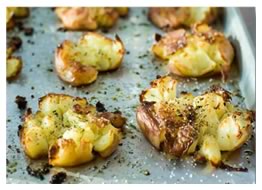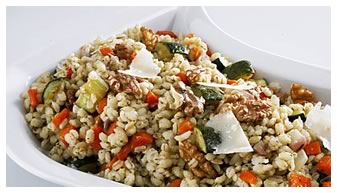Notes from Debbie's Kitchen~~~~~~~~~~~~~~~~~~~~~~~~~~~~~~~~~~~~~~~~~~~~~~~~
Click here to go to recipe database.
Not so many recipes this week ~ I got a late start ;-) Hope you like what I came up with though! As always, my comments are in [square brackets]. - Debbie The following was sent to me by member Laurel Pavesi, and is simple and yummy! (I've tried it.) Love the photo too - gives you a good 'picture' of how they should come out.Crash Hot Potatoesfrom thepioneerwoman.comNew potatoes (or other small round potatoes) [perfect! That's what we have!]
Olive oil
Kosher salt [or good, flavorful sea salt; regular salt will do in a pinch]
Black pepper
Fresh rosemary, chopped (or thyme, or chives or whatever herb you have available)
[You could optionally include minced fresh garlic!]

Bring a pot of salted water to a boil. Add in as many potatoes as you wish to make and cook them until they are fork-tender [so, somewhere in the 10- to 15-minute range; careful: too long and they'll fall apart!]
On a sheet pan, generously drizzle olive oil. Place tender potatoes on cookie sheet leaving plenty of room between each potato.
With a potato masher [or flat side of a chef knife], gently press down each potato until it slightly mashes, rotate the potato masher 90 degrees and mash again. Brush the tops of each crushed potato generously with more olive oil.
Sprinkle potatoes with [optional minced garlic] kosher salt, fresh ground black pepper and fresh chopped rosemary (or other herb).
Bake in a 450 degree oven for 20 to 25 minutes until golden brown.
Member Lisa Bautista sent me this gem from the San Francisco Chronicle (modified the title to reflect the key ingredients):Barley with Walnuts and Roasted Carrots, Zucchini and Radishesby Chronicle staff writer Tara Duggan [original title: "Barley with Walnuts & Roasted Spring Vegetables"]
photo credit: Eric Luse/Chronicle
serves 6 to 8"The Parmesan, nuts and seasonal vegetables help turn the hearty barley into a vegetarian main course; serve it with a salad. This also makes a delicious side to roasted or grilled meat dishes."

2 C hulled or pearl barley
1 tsp. kosher salt + more to taste
12 oz. carrots, peeled and cut into medium dice [who measures carrots in ounces?? Just do a couple carrots; much as you want]
8 oz. zucchini, cut into large dice [ditto for squash]
5 radishes, cut into medium dice
1 C chopped red spring onion, greens reserved (see Note)
2 tbsp. extra-virgin olive oil + more to drizzle
2 tsp. chopped fresh thyme
2 tsp. chopped fresh rosemary
1 clove garlic, chopped
-- Freshly ground black pepper, to taste
1/2 C walnut pieces
-- Reserved spring onion greens (optional), thinly sliced
1/2 C grated Parmesan cheese [I notice in the photo that they used shaved Parmesan; not a bad idea for garnish, anyway!]
Place the barley and 1 tsp. salt in a pan with 4 1/2 cups water. Bring to a boil, then reduce to a simmer and cook, stirring often, until the grains are tender with a slight crunch and most of the water has evaporated, 35-40 minutes. Spread out on a baking sheet and let cool. Do not drain unless there is a lot of extra liquid; if so, save the liquid in case the barley seems dry later.
Preheat the oven to 400 degrees.
Combine the carrots, zucchini, radishes, spring onions, 2 tablespoons olive oil, thyme, rosemary, garlic in a large bowl. Add plenty of salt and pepper to taste. Spread out on a baking sheet so that all of the vegetables touch the pan, and roast until tender, about 20 minutes.
Meanwhile, place the walnut pieces on a small baking pan place in the oven. Watch carefully, and remove when the pieces begin to color, 8-10 minutes at most.
Toss the vegetables with the barley and the spring onion greens, if using, and spread out on the pan you used to roast the vegetables. Reduce the oven to 350° and cook until the barley is warmed through, about 10 minutes.
Toss in the Parmesan and nuts, if using, and a drizzle of olive oil. Add some of the reserved water if it seems dry. Taste for more salt and pepper, and serve immediately.
Note: You can use an equal amount of green spring onions or red onion instead.
The next recipe was sent in by member Marie Cardenas last month; she says, "it uses lots of veggies from the share".Green Velvet Soupfrom allrecipes.com, with this comment: "A great green color and smooth, rich texture. Comfort food! Freezes well."Marie's comments: "It takes just 15 minutes if you cook the split peas in a pressure cooker (15psi), drop the pressure and add in the veggies (I used 1 bundle of collard greens without stems, 1 bag of broccoli with stems/leaves, summer squash), put back to pressure for 10 minutes more, then puree with a hand blender. We topped it with parmesan cheese. I did not use potatoes nor broth (just water), yet it still tasted great!"
1 onion, chopped
2 stalks celery, sliced
2 potatoes, diced
3/4 C dried split peas
2 bay leaves
6 C vegetable broth [or water, says Marie]
2 zucchini, diced [any farm summer squash will do]
1 head broccoli, chopped [broccolini can be substituted no problem]
1/2 tsp. dried basil
1/4 tsp. ground black pepper
4 C chopped fresh spinach [or other cooking green]
salt to taste
[dollop of sour cream or thick, plain yogurt as optional topping]
In a large pot over medium heat, combine onion, celery, potatoes, split peas, bay leaves and broth. Bring to a boil, then reduce heat, cover and simmer 1 hour.
Remove the bay leaves and stir in the zucchini, broccoli, basil and black pepper. Simmer 20 minutes, until broccoli is tender.
Stir in spinach and remove from heat. [If using collards or kale or any firmer cooking green, I'd recommend cooking maybe 5 minutes more, or adding the greens 5 minutes earlier, so they're 'done' concurrent with the other veggies.] Puree all in a blender or food processor, or use an immersion blender. Salt to taste.
[garnish optionally with a dollop or squirt or drizzle of sour cream, or as Marie says, top with Parmesan cheese!]
Here's a recipe given me back in 2007 by member Caroline Martin...Potato and Green Bean Salad with creamy cucumber dressingFrom Cuisine at Home Magazine
Makes about 4 cups1 lb. potatoes (with skins), quartered
2 eggs, boiled and sliced
4 oz. fresh green beans, trimmed [just approximate; use as many as you think will go nicely with a pound of potatoes!]
3/4 C seeded, coarsely grated cucumber
large pinch of salt
2 tbsp. mayonnaise
2 tbsp. plain yogurt
1 tbsp. minced fresh tarragon
1 tbsp. minced fresh parsley
2 scallions, minced
1/2 tsp. Dijon mustard
juice of half a lemon
salt and pepper to taste
Caroline says the original recipe says to boil potatoes and eggs together for 12 minutes, then add beans for another 3, but she prefers to cook them separately. Slice the boiled eggs.
Toss the cucumber with the salt and put in a strainer. Drain for 15 minutes, then squeeze well to remove excess moisture.
Whisk mayo, yogurt, herb, scallions, mustard, lemon juice, salt and pepper together in a large bowl, add the drained cucumber. Gently toss potatoes, beans and eggs with the dressing. Serve warm, room temp. or cold.
Beet and orange are two wonderfully sympatico flavors. This next recipe comes from some folks I met at a pot-luck a few years back. They brought this delightful beet dish...Clint and Terry's roasted beets with orange sauceTerry's description: "This is very easy. Peel and slice beets up thinly, roast in butter till you like them, a bit crisp is nice. [She didn't specify cooking time or technique... I'd probably put sliced beets well dotted with butter in a glass dish and cover/bake at, say, 375 degrees. Check after half an hour... see if they're 'crisp and nice' yet. Possibly uncover and bake a little longer to 'make crisp'.] While roasting cook down the juice from a couple oranges (or use about 1/2 cup or so of prepared orange juice) until thickened to a glaze; wide fry pans work very quick to reduce liquids. I also added a bit of tamari with the orange juice. The original recipe called for maple syrup too, but since the beets were so sweet it was not needed." [I'd then take the reduced orange-tamari sauce, pour it over the beets, return to the oven and heat a little longer until all is bubbly.]